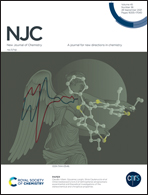Insights into the kinetics and molecular mechanism of the Newman–Kwart rearrangement
Abstract
The kinetic and thermodynamic parameters of Newman–Kwart rearrangement (NKR) of N,N-dimethyl O-arylthiocarbamate into N,N-dimethyl S-arylcarbamate have been evaluated using the Minnesota density functionals (M06-2X and MN15-L) conjugated with the aug-cc-pVTZ basis set and compared with benchmark CBS-QB3 results. Environments of diphenyl ether and o-dichlorobenzene solvents were simulated implicitly by means of the SMD solvation model. The employed temperatures 505 K in diphenyl ether and 413 K in o-dichlorobenzene were more than two times larger than the cross-over temperature, implying shallow tunneling. The evaluated kinetic and energetic parameters using the CBS-QB3 method were in excellent agreement with the experimentally supplied data. The rate constant in diphenyl ether can be expressed by original and modified Arrhenius equations kCBS-QB3/Eckart404-606K = 6.46 × 1012 exp(−19944.6/T) and kCBS-QB3/Eckart404-606K = 1.26 × 1010T0.865 exp(−19516.8/T), respectively. Topological evolution along the reaction has been studied at the B3LYP/CBSB7 level in an o-dichlorobenzene environment using the quantum chemical topology tools. The electron density in C–O and C–S bonds was strongly polarized toward the oxygen and sulfur atoms, respectively, in such a manner that carbonyl and thiocarbonyl bonds cannot be described by Lewis's bonding model. Topological and chemical events along the reaction may be described as: (i) formation of a new monosynaptic basin V(C1) associated with the pseudoradical center on the ipso-carbon atom by means of Fold (F†) type catastrophe, and (ii) transformation of disynaptic basin V(C1,O) into the monosynaptic basin V3(O) associated with the heterolytic rupture of the C1–O bond by means of elliptic umbilic (E) catastrophe, and merging of V3(S) and V(C1) monosynaptic basins into the new disynaptic basin of V(C1,S) associated with the formation of the C1–S bond via usual sharing of the non-bonding electron densities (C1-to-S coupling of pseudoradical centers) by means of a Cusp (C) type catastrophe. The detailed picture of chemical events along the NKR reveals that the electron density flow does not take place in a cyclic and one-way curve, suggesting a non-concerted mechanism.



 Please wait while we load your content...
Please wait while we load your content...